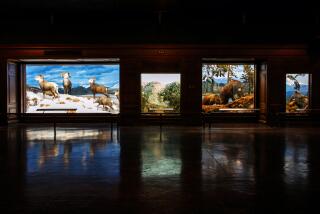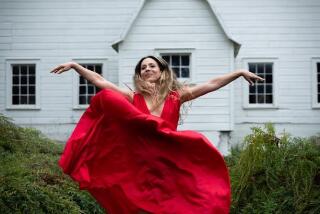The Bjorkatastrophe in verse: A girl critic takes her beating heart to MoMA

A mannequin bearing Björk’s likeness is on view at the Museum of Modern Art’s retrospective on the work of the Icelandic composer and singer. It features an Iris Van Herpen dress that the singer wore during her Biophilia tour in 2011.
“Once there was a girl, a girl who lived alone in a lava field in a forest.”
So begins the audio guide to the Björk retrospective at the Museum of Modern Art. It goes downhill from there. Way downhill.
This rambling narrative poem, created by the Icelandic writer Sjón in collaboration with Björk, takes the viewer on a metaphor-stuffed ride through the exhibition -- at least I think they’re metaphors -- chronicling the work of the experimental singer and composer. Its general purple-ness is made more abhorrent by the fact that it serves as the spine of this very thin show.
Instead of supplying the viewer with any sort of background, context or influences that may inform Björk’s work, the audio guide dispenses phrases such as, “a song could be saved like a coconut with purple hair” and “she was a mother girl now, a girl mother.”
But there is more. Oh, so much more.
Such as: “The girl brought to life the forces that had shaped her.”
Or: “The girl knew she was ready to say I do and the young bride echoed the heart’s emotions.”
As well as: “The sand of the old country, nothing was forgotten, she was the hunter, all was full of love.”
Like the show, which is almost absent of content, the audio guide has been widely panned. Roberta Smith at the New York Times called it “ludicrously infantilizing and tedious.”
But after listening to the audio closely for almost an hour as I made my way through the exhibition this past weekend, I found myself being seduced by its sublime ridiculosity: the nonsensical non-sequiturs (a coconut with purple hair!) and the adventures of the girl mother, the mother girl. Plus: lava, lots of it. It’s the sort of language that would make Yoda proud.
The whole thing inspired me to write my own epic narrative poem about my visit to MoMA to see the show — complete with coconuts:
Once there was a girl, a girl from the dry riverbeds of the West
a girl who read and wrote, and wrote and read
a girl shaped by the forces of landslides and earthquakes and multiple daily deadlines.
A critic girl, a girl critic.
Into the dim rooms of the glittering exhibition palace she gently stepped,
a palace of the Modern,
far away from the concrete river beds of a city named for angels.
An inky pavilion, a pavilion the color of black lava,
she plunges with her audio guide,
a guide the color of black lava, dew-covered lava, fields of lava —
because the writers of the audio guide love the repeated sound of ‘lava’ on the tongue,
moving lava, frozen lava, charcoal lava because Iceland is made of lava
and lava sounds cool and tectonic
and because there is no flowing hot lava in New York,
only dried up bedrock,
even though it’s the capital of the world.Entering the narrow labyrinth,
she finds a birth canal of breathy lyrics
and feral dresses made of yarn
and beating hearts, and hearts that beat,
because the only thing the writers like more than lava
is the sound of a heart that is beating.
The critic girl, the girl critic paces
back and forth and forth and back,
amid bright frocks and coffee-splashed diaries.
In this womb of plywood and drywall, she finds the other girl, the lava girl,
a girl who saved songs like coconuts with purple hair, the mother girl, the girl mother,
a girl who was once fileted by Matthew Barney on a silver screen.
The critic girl meets the lava girl.
The lava girl is rendered in miniature, next to a pair of shoes
and a wall of blinking LEDs, reminiscent of a video game from “Hyperballad.”
Then, a puffy white coat from “Joga,”
her coolly blinking eyes in “Homogenic,”
and her face, the lava girl’s face,
on the cool white form of a robot, a girl robot, who is “Full of Love.”
The girl continues, step by step,
the critic girl, girl critic
listening to the audio guide, with its stories that are free, so free —
free of context, free of facts, free even of the lava girl’s name,
a lava girl, in the shadow of 50, still being described as a ‘girl.’
Past the piercing pearl dress “Pagan Poetry,” floating on a lazy susan,
she goes into a chamber with a jangling bell dress,
and another in which a swan cradles a woman’s neck menacingly,
rooms of bright tribal knits and blue hair feathers.
It is all there.
Objects. On display. Like a planet of Hollywoods.
And the visitors, their smiles come quicker, and disappear quicker,
as the audio guide comes quicker, and jams quicker,
the room filled with frozen handsets, continuously wedged on track one.
Close huddles of viewers confused and befuddled,
trying to find wall text,
trying to find any kind of explanation.
The line of beating hearts, and hearts that beat
waiting, waiting, waiting
to dance, to feel, to think
to snap a selfie with the bell dress by Alexander McQueen.
The breath inhales. The breath exhales.
The critic girl emerges from the darkness
dazed, confused, knowing no more about the lava girl than when she’d went in.
But it is over. And she is now in the bright white light,
a ballet of travelers dancing around the escalator
beyond which lies the great migrations of Jacob Lawrence
and the possibility of redeeming the afternoon.
“Björk” is on view at the Museum of Modern Art through June 7. 11 W. 53rd St., New York, moma.org.
Find me on Twitter @cmonstah
More to Read
The biggest entertainment stories
Get our big stories about Hollywood, film, television, music, arts, culture and more right in your inbox as soon as they publish.
You may occasionally receive promotional content from the Los Angeles Times.










